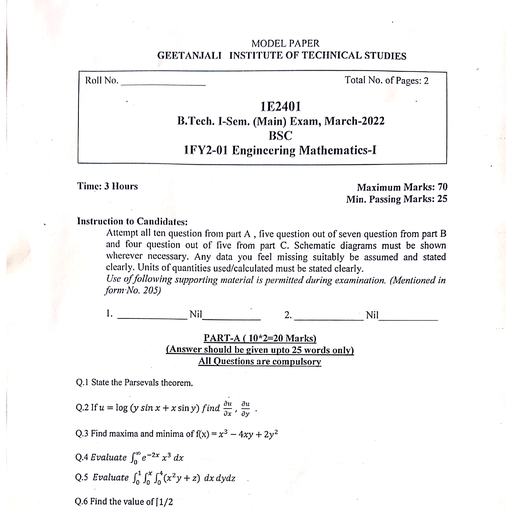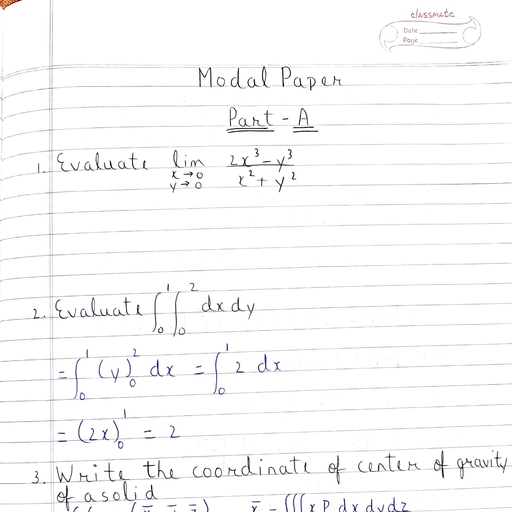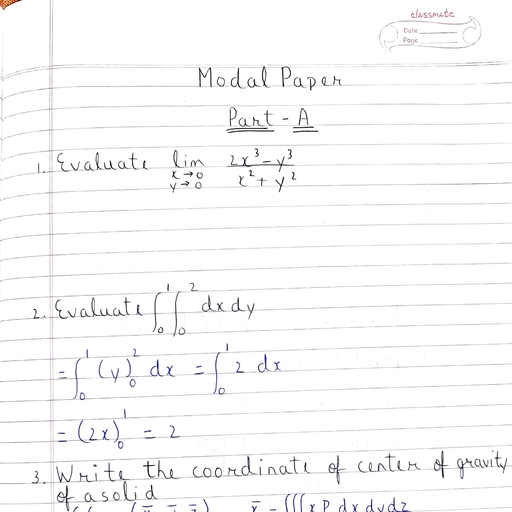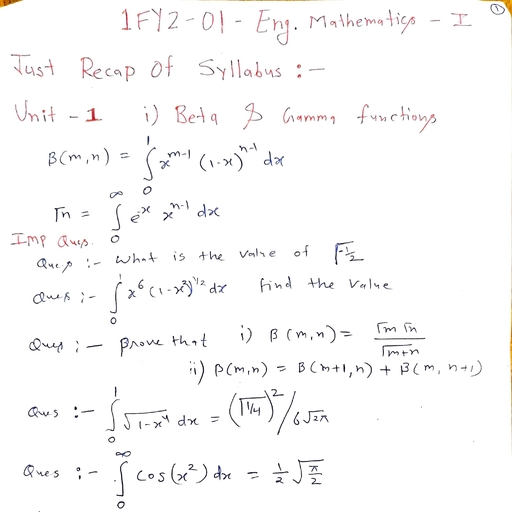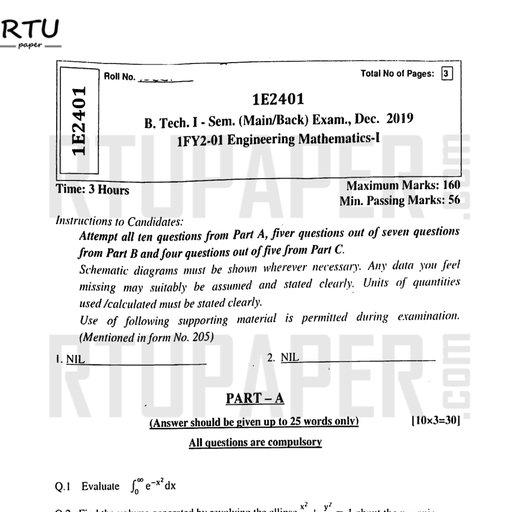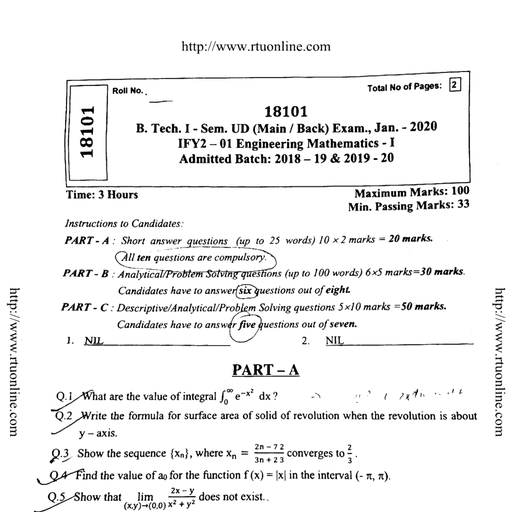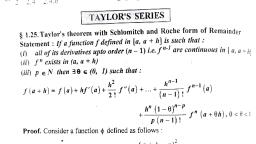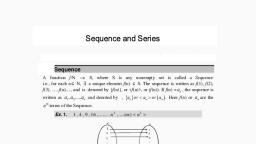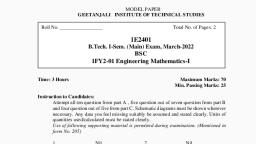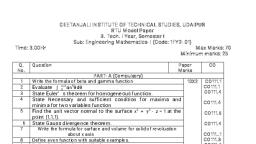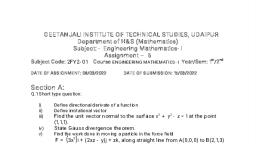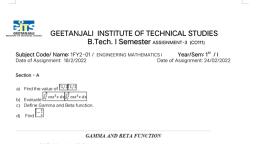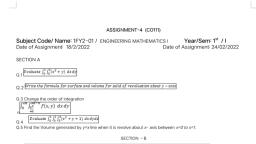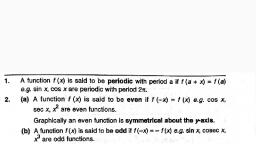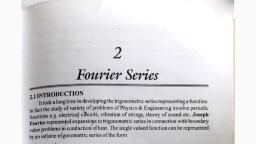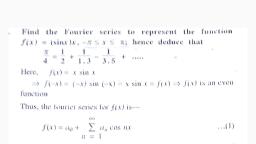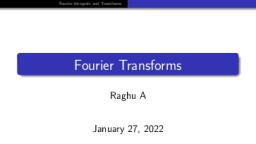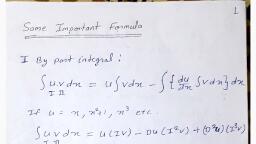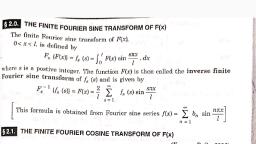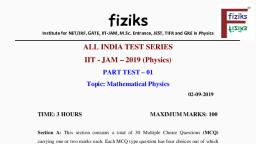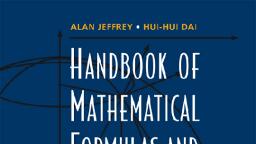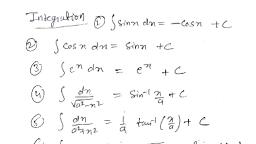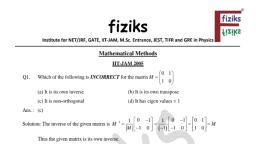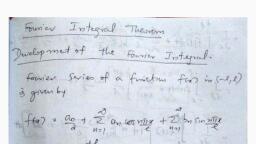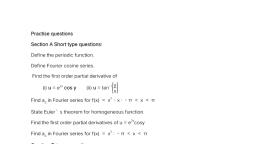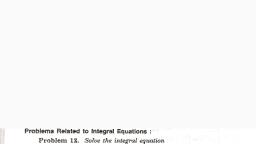Page 1 :
2, Fourier Series, 2.1 INTRODUCTION, It took a long time in developing the trigonometric series representing a function., In fact the study of variety of problems of Physics & Engineering involve periodic, functions e.g. electrical circuits, vibration of strings, theory of sound etc. Joseph, Fourier represențed expansions in trigonometric series in connection with boundary, value problems in conduction of heat. The single valued function can be represented, by an infinite trigonometric series of the form, +a, cos x + a, cos 2x +, az, cos 3x +....+ b, sin x+ b, sin 2x..., within the desired range of the values of the variables. Such a series is known as, Fourier Series. The study of conditions under which such expansions are possible, and then determination of the coefficients of the series is known as Fourier Analysis., 2.2 PERIODIC FUNCTIONS, If at equal intervals of abscissa x, the value of each ordinate f(x) repeats itself, i.e. f(x) = f(x + T) then f(x) is said to be a periodic function., If T is the smallest positive number for which such a relation is satisfied, then, Tis called the period of the function., For example The simplest periodic functions are sin x and cos x having, period 2n. Their reciprocals cosecx and secx are also periodic with period 2n, tan, x and cot x are periodic with period a, The functions sin nx and cos nx are periodic with period, The sum of a numl, of periodic functions will also be a periodic function. For, example, 1, 1, sin x +-sin 2x +-sin 3x +-sin 4x, 2, Is'a periodic function. The periods of the terms are 2n, T,, and, respectively., 3, So the period of the function is the least common multiple of these periods i.e. 2n., Scanned by CamScanner, 一
Page 2 :
Scanned by CamScanner, Advanced Engineering Mulmemunc, 2.2, 2.3 FOURIER SERIES, Fourier Series, 2.3, The conditions (i), (ii), (iii) imposed on f(x) are sufficient but not necessary, ie. if the conditions are satisfied the convergence is guaranteed. However, if they, to f(x) is defined to be, are not satisfied, the series may or may not converge. The conditions are generally, satisfied in cases which arise in science and engineering., f(x) =+E[a, cos nx + b, sin nx], ..(1), There are at present no known necessary and sufficient conditions for conver-, n=1, gence of Fourier series. It is of interest that continuity of f(x) does not alone insure, where the coefficients a, a, b, are, convergence of a Fourier series., In the subsequest articles, the following definite integrals will be useful., a+2*, a+2n, a+27, (i) cosnxdx = 0, (ii) sin nx dx = 0, a+27, S S(x)cosnx de, a, =-, a+2x, a+2n, ..(2), (iii) cosmxcosnx dx 0, (iv) sin mxsin nx dx = 0, a+27, Į S(x)sin nx dx, CL, a+2n, a+2x, (v) | sin mx cos nx dx 0, (vi) cos nx dx = n, It is interesting to note that series (1) is the only series corresponding to, f(x). We do not know whether the series converges and even if it does converge,, whether it converges to f(x). This problem of convergence was examined by, Dirichlet who developed conditions for convergence of Fourier series which we, a, a+2n, nx dx = T, (vii) sin2,, now consider., 2.5 DETERMINATION OF FOURIER COEFFICIENTS, (EULER'S FORMULAE), To determine the coefficients a,a,b,, we assume that series (1) is uniformly, 2.4 DIRICHLET'S CONDITIONS FOR A FOURIER SERIES, 9049, (i) f(x) is finite, single valued and periodic function in the interval a <x<a +2n, (ii) It has a finite number of discontinuities and all of them are of the first kind, i.e. at each discontinuity , the function f(x) has a finite limit on the left and finite, convergent so that the term by term integration is permissible from x a to, x=a +2n., To find a, : Let us integrate both sides of (1) with respect to x between the, limits a and (a + 2n), we get, limit on the right i.e., f(-0)= Lim f (-h), a+2n, a+27, a+27, ao, a+2n, | dr +a, cos nx dx +b, [ sin nxdx, 2, and, %3D, n=1, n=1, f(E+0) = Lim f (E +h);h>0, ho, both exist but are different, do, (iii) f(x) has a finite number of maxima and minima., Then the series (1) with coefficients (2) converges to, a+2r, (a) f(x) if x is a point of continuity,, 1, An =-, S (x)dx, a, f(x+0)+ f(x-0), To find a, : Multiply both sides of (1) by cos nx and integrate with respect to, x between the limits a and a + 2n, we get, (b), if x is a point of discontinuity.
Page 3 :
Scanned by CamScanner, Advanced Engineering Mathematics- 3, 2.4, a+21, a+2, an, a+2n, cos nx dx+ a, cos nx dr, S s(x)cosnx dr=-, 2, Fourier Series, Cor 2. If a=-n, then the interval becomes -n<x<n and the coefficients, n=1, a., 2.5, take the form, a+2n, 2 cosnx sin nx de, 1, do =-, n=1, a, 0+ח, +0=, a, =, a+2n, 1, S S(x)cosnx dx, a, =-, Similarly, we can find b, by multiplying each side of (1) by sin nx., b,, anx dx, a+2n, J S(x)sin zx dx, Remark 1. The formula (1) is derived on the assumption that the function f(x), is continuous in a<x<a+ 2n, In case f(x) is discontinuous at x = x, such that, Thus Fourier series for f(x) in the interval (a,a+ 2n) is, [A(x), f (x) =|, a<x< Xo, Xo <x<a + 2n, a, cosnx+ b, sin nx, ...(1), a+2r, 1, a, =-, Yt, n=1, then, α, a+2x, where as()de, S(x)dx, a+2n, SA(x)dx+ f(x)dx, =-, a+2n, S (:)cosnxdx, a, =-, a+2n, Similar would be the expression for a, and b,, Remark 2. The value of the coefficients a, a, .. a, .., .(2), a+2n, b. =-, S s(x)sin nxdr, in general can be, found by putting n= 1,2,3,... in the value of a, but the value of a,can not be found, in such a manner. Hence a separate formula for a, is necéssary., These values of a, , a,, b, are known as Euler's formulae,, Cor 1. Putting a = 0, the interval becomes 0 <x < 2n and the coefficients, e.g., f(x) = x2, 0 <x< 2n, reduce to the form, a, =, 27, Remark 3. The fourier series, being trigonometric function, is obviously peri-, odic (because sum of the periodic functions is again a periodic function). Hence, a, =-, 1, a, =-, Ss(x)cosnx di, unless f(x) is periodic, the equality relation in f(x)=+[a, cosnx +b, sin nx], holds only in the length of the interval 2n for which f(x) is defined., Remark 4. In solving the problems on Fourier Series, we require repeated, use of the process of integration by parts. We have the following general rule., 2n, b, = f(x)sin nxdx
Page 4 :
Scanned by CamScanner, Advanced Engineering Mathematics - 3, 2.6, fuvdr = u(iv)-(Du)(r°v) -(D*u)(r*»), Fourier Series, 2.7, (-2)(-1)", u =x, the right hand side terminates at D" u., Other useful results for neI, ,b, =D, etc., Now substituting the values of a's and b's in (1), we have, sin n = 0, cos NT =, m%=(-1)",, cos x cos 2x cos3x, 4, sin x sin 2x sin 3x, +2, 3., 12, 22, 32, 3, sin (2n +1)a =(-1)", cos (2n+1)7=0, Example 2. Develop the Fourier series to represent the function f(x)3e*, in the interval 0<x< 2n., 2.6 ILLUSTRATIVE EXAMPLES, Example 1. Find the fourier series to represent the function, Sol . Let f(x)=e =+[a, cosnx + b, sin nx], do, %3D, [Raj. 2000], ...(1), n=1, f(x)=x-x,, () =1-r' =,[(2,, ...(1), a, cosnx+ b, sin nx), where, a, =-, %3D, Sol. Let, 2, n=1, 2n, -2π, 1-e, Se, Then, a, =, x-xdx =, 2n, x-x*)cosnxdx, [e* cos nx dx, Also, a, =-, Also, an =-, sin nx 1-2x, sin nx, Cos nx +, n°, e-*{-cosnx + nsin nx}, an, %3D, е, +1, - 2n, 1+2n, +0, %3D, a,, as cos 2nn = 1, a(n* +1), 4, " sin nn =0, (1-) 1, an, (-1)"., CosnT =, a, =, 4, a, =, etc., (1-e) 1, a, =, 1, Again b, =-, S(x-x* )sin nxdx, 2n, 2n, 1, bn, S(x)sin nxdx=- fe*sin nx dr, Here D" and " stand for and n If
Page 5 :
Scanned by CamScanner, Advanced Engineering Mathematics- 3, 2.8, (1-), (*+1), Fourier Series, 2.9, "q., a,, -2, ,a =, -2, 152 **, (1-e), -2x, (1-), -etc., 5, %3D, 2, |-nsin nx dx + xsin nx dx, Substituting the values of a,, ap and b, in (1), we have, (1-e-27, 1, cosx+-cos 2x+., 1-20 m)= [1-2(-1)"], 1, %3D, sin x+-sin 2x+, Example 3. Find the fourier series to represent the function, b, = 3, b, =, h, ==, etc., -π<x<0, con , ), cos 3x cos 5x, +, TO, Hence f(x) =-"-, 0<x<T, cos x +, 4, 32, Find also the sum of the series for x= 0 andx=±n., sin 2x 3sin 3x sin 4x, +3sin x-, Sol. Let f(x) =+a, cos nx + b, sin nx], Again x = 0, ±n are the points of discontinuity. When x 0, the value of the, series is, where a, =-, f(0+)+ f (0-), 0-T, -ndx+ [xdx, %3D, 2, y =x, Also when x = T, the value of the series is, f(T+)+f(n-), Also · a, =-, COs nx dx, -2n, 2n, -T + T, y=-T, %3D, = 0, J-ncos nx dx +, 2, Similarly when x = -T, the value of the series is zero., Example 4. Develop the Fourier series for the fumction f(x) =x+x' in the, 1 cos nx -1, n?, (-1)", interval -n <x< T. Hence show that, = 0 when n is even, 1, 1, =1+, 22 32, [Raj. 2001, 2003, 2004, 2006, 2007, +..., ,2, when n is odd, MNIT 2003, 2005, RTU CE 2009, EE 2009, EČ 2009, ME 2009], a, = 0= a, = a6 =....., Sol. Let f(x) =x+x² = + E[a, cosnx + b, sin nx], ...(1), 2, n=1
